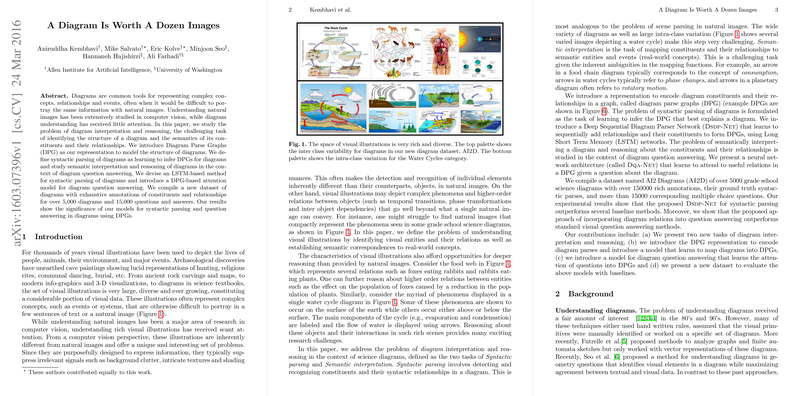Analyzing "A Diagram Is Worth A Dozen Images"
The paper "A Diagram Is Worth A Dozen Images" by Kembhavi et al. explores the under-researched challenge of diagram interpretation and reasoning in the field of computer vision. While significant advancements have been made in understanding natural images, the semantic interpretation of diagrams, which condense complex concepts into visual representations, remains an open challenge. The authors introduce the novel concept that diagrams could potentially convey as much information as multiple natural images.
The core contribution of the paper can be segmented into several key areas: the introduction of Diagram Parse Graphs (DPGs), the development of the Deep Sequential Diagram Parser (DSDP-Net) for syntactic parsing, and a model named DQA-Net for diagram question answering. The integration of these constructs addresses the twin challenges of syntactic parsing of diagrams and the subsequent semantic interpretation necessary for reasoning.
Methodological Innovations
Firstly, the introduction of DPGs serves as a powerful analytical tool that encapsulates the graphical and semantic composition of diagrams. DPGs encode entities and their relationships within a diagram, translating the spatial and logical structures into a graph-based format suitable for computational inference. This representation is designed to capture the extensive variability inherent within diagrams, from inter-object linkages to intra-object region labelling.
For syntactic parsing, the DSDP-Net employs a sequential framework leveraging LSTMs, which effectively models the dependencies between diagrammatic components and their graphical relationships. The network utilizes a series of relation proposals, processed sequentially to generate a DPG that optimally reflects the diagram structure. This approach is demonstrated to be superior to traditional algorithms such as greedy search or A* search in generating syntactically accurate representations of diagrams.
The authors also bring forth the DQA-Net, which supports diagram question answering by integrating attention mechanisms over the DPG representation. This attention-based approach facilitates the reasoning process by enabling the system to focus on relevant diagram components in response to query signals. By leveraging the DPG-based attention model, the system outperforms baseline visual question answering models when applied to diagram-specific tasks, indicating a robust method for capturing the semantics of a diagram.
Implications and Future Directions
The implications of this research are multifaceted, impacting both theoretical and practical domains in AI and vision systems. Pragmatically, effective diagram interpretation could enhance educational tools, allowing systems to automatically interpret and generate quizzes from educational diagrams. Theoretically, the robust handling of diagrams broadens the horizons of visual understanding systems, equipping them to tackle more abstract and generalized visual reasoning challenges.
In terms of future work, the authors identify several avenues for development, including integrating commonsense knowledge and domain-specific information to further enrich the semantic understanding derived from diagrams. Moreover, expanding the dataset and refining the computational models could enhance the system's capabilities and its applicability across a broader array of domains.
The research presented in "A Diagram Is Worth A Dozen Images" marks a substantial step forward in the field of diagrammatic reasoning within computer vision, setting the stage for future innovations that bridge the gap between natural image interpretation and complex diagram understanding.
